Taxonomy: Class: Mammalia; Order: Carnivora; Family: Mustelidae
Description
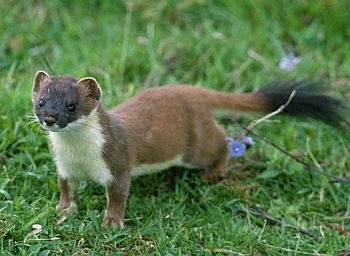
Stoat © Laurie Campbell
The stoat is a small slender carnivorous mammal native to Britain. It is larger than the weasel, with a black-tipped tail. In winter some animals may turn completely white apart from the tail tip. The stoat's main prey is the rabbit, and numbers of stoats declined drastically when myxomatosis devastated the British rabbit population in the 1950s and 1960s. The stoat also commonly eats gamebirds, waders, eggs and chicks. It may be culled throughout the year.
Further information:
Mammal Society website stoat page.
Conservation status and legislation
Status:
UK: Native
World: Least Concern (IUCN Red List)
Legislation:
Distribution and abundance
The stoat lives throughout Britain, although its presence on the Scottish islands is restricted to Shetland, Islay, Jura, Mull, Skye, Raasay and Bute. It is also found on the Isle of Wight and Isle of Man. It occupies the whole of Ireland, despite the paucity of records on the map.
Estimates of stoat abundance (numbers of individuals in the spring) across the UK, from Harris et al. (1995):
Recent trends from the National Gamebag Census
United Kingdom
Index of bag density from 1961 to 2009 (see statistical methods and interpretational considerations).
Error bars represent 95% confidence intervals.
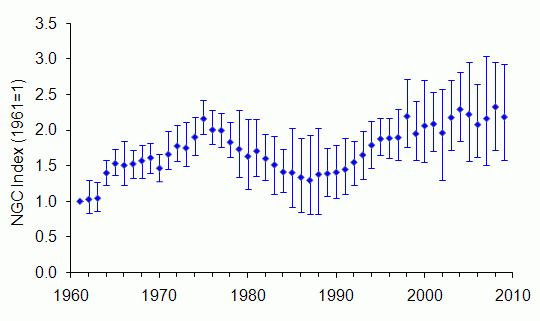
The bag index has doubled between 1961 and 2009, but with a notable broad-based dip during the 1980s followed by recovery during the 1990s. Broadly, the increase follows that of its main prey, the rabbit, although it is not obvious why the dip occurred.
Change in stoat bags over time, with 95% confidence limits (see statistical methods):
| Country |
Sites |
Start
year |
End
year |
Change (%)
1961-2009 |
Change (%)
1984-2009 |
Change (%)
1995-2009 |
| United Kingdom |
1072 |
1961 |
2009 |
117*
75 to 173 |
50*
23 to 80 |
28*
12 to 42 |
* significant at P < 0.05
England
Index of bag density from 1961 to 2009 (see statistical methods and interpretational considerations).
Error bars represent 95% confidence intervals.
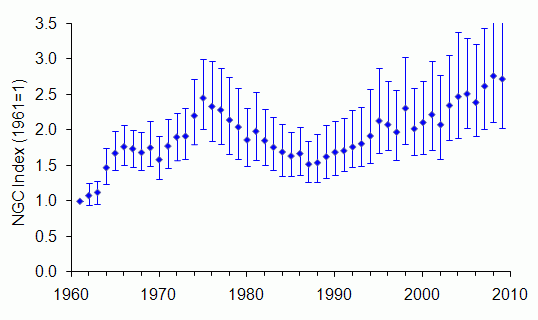
The bag index has more than doubled between 1961 and 2009, but with a notable broad-based dip during the 1980s followed by recovery during the 1990s. Broadly, the increase follows that of its main prey, the rabbit, although it is not obvious why the dip occurred.
Change in stoat bags over time, with 95% confidence limits (see statistical methods):
| Country |
Sites |
Start
year |
End
year |
Change (%)
1961-2009 |
Change (%)
1984-2009 |
Change (%)
1995-2009 |
| England |
781 |
1961 |
2009 |
150*
88 to 228 |
53*
25 to 97 |
42*
22 to 69 |
* significant at P < 0.05
Scotland
Index of bag density from 1961 to 2009 (see statistical methods and interpretational considerations).
Error bars represent 95% confidence intervals.
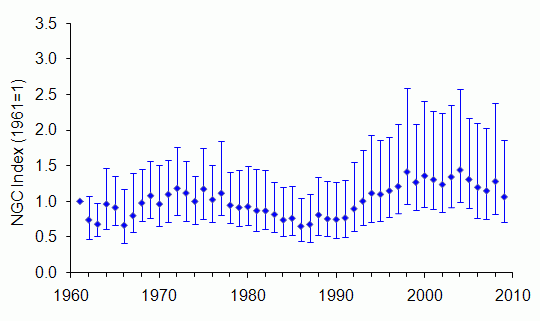
A broad-based dip during the 1980s was followed by a recovery during the 1990s, leading to a significant increase between 1984 and 2009. Overall, however, there was no detectable change between 1961 and 2009.
Change in stoat bags over time, with 95% confidence limits (see statistical methods):
| Country |
Sites |
Start
year |
End
year |
Change (%)
1961-2009 |
Change (%)
1984-2009 |
Change (%)
1995-2009 |
| Scotland |
250 |
1961 |
2009 |
49
-8 to 156 |
51*
11 to 96 |
11
-6 to 34 |
* significant at P < 0.05
Wales
Index of bag density from 1961 to 2009 (see statistical methods and interpretational considerations).
Error bars represent 95% confidence intervals.
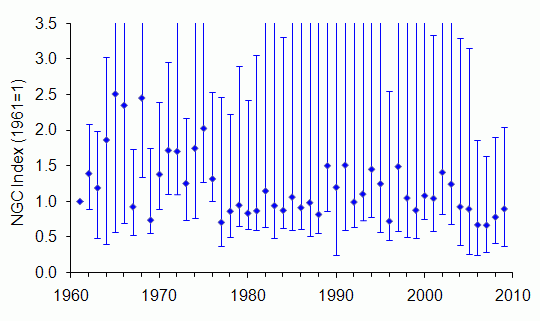
Despite large standard errors on the estimated values, there has been a significant decline between 1995 and 2009. As numbers of its main prey, the rabbit, have increased during the period, the trend may reflect a gradual abandonment of traditional gamekeeping in Wales.
Change in stoat bags over time, with 95% confidence limits (see statistical methods):
| Country |
Sites |
Start
year |
End
year |
Change (%)
1961-2009 |
Change (%)
1984-2009 |
Change (%)
1995-2009 |
| Wales |
29 |
1961 |
2009 |
-48
-70 to 88 |
-23
-80 to 20 |
-35*
-71 to -2 |
* significant at P < 0.05
N Ireland
There are too few bag records of stoat to produce an index graph. 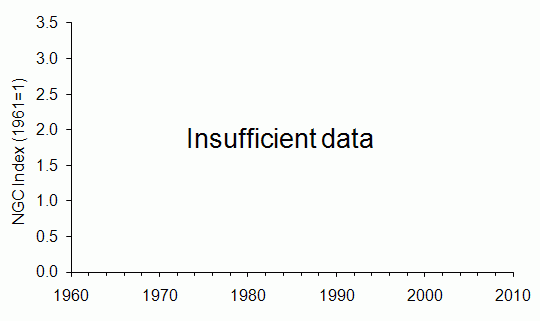
There are too few bag records of stoat to evaluate rates of change over time
| Country |
Sites |
Start
year |
End
year |
Change (%)
1961-2009 |
Change (%)
1984-2009 |
Change (%)
1995-2009 |
| N Ireland |
Too few sites |
Environmental zones
Change in stoat bags over time, with 95% confidence limits (see statistical methods):
| Environmental zone |
Sites |
Start
year |
End
year |
Change (%)
1961-2009 |
Change (%)
1984-2009 |
Change (%)
1995-2009 |
| Easterly lowlands (England/Wales) |
511 |
1961 |
2009 |
64*
10 to 142 |
-12
-35 to 21 |
7
-23 to 42 |
| Westerly lowlands (England/Wales) |
186 |
1961 |
2009 |
12
-30 to 93 |
-13
-49 to 3 |
-3
-32 to 33 |
| Uplands (England/Wales) |
110 |
1961 |
2009 |
394*
131 to 770 |
224*
157 to 297 |
77*
47 to 111 |
| Lowlands (Scotland) |
76 |
1961 |
2009 |
22
-41 to 158 |
-21
-57 to 45 |
-37
-64 to 8 |
| Intermediate uplands/islands (Scotland) |
39 |
1961 |
2009 |
-1
-49 to 101 |
-3
-47 to 65 |
10
-39 to 79 |
| True uplands (Scotland) |
137 |
1961 |
2009 |
62
-12 to 237 |
87*
28 to 157 |
26*
7 to 49 |
* significant at P < 0.05
Comparison with BBS mammal data
No comparison with the NGC trend is possible because too few stoat records are received through the Breeding Bird Survey (BBS) organised by the British Trust for Ornithology.
Long-term trend from the National Gamebag Census
There are too few bag records of stoat to produce a trend starting before 1961.
References and further reading
- Battersby,J. (2005). UK Mammals: Species Status and Population Trends. Joint Nature Conservation Committee/Tracking Mammals Partnership, Peterborough (JNCC download page).
- Harris,S., Morris,P., Wray,S. & Yalden,D.W. (1995). A Review of British Mammals: Population Estimates and Conservation Status of British Mammals Other than Cetaceans. Joint Nature Conservation Committee, Peterborough (JNCC download page).
- Harris,S. & Yalden,D.W. (2008). Mammals of the British Isles: Handbook, 4th edition. Mammal Society, Southampton.
- McDonald,R. & Harris,S. (2006). Stoats and Weasels. Mammal Society, Southampton.
This report should be cited as: Aebischer,N.J., Davey,P.D. & Kingdon,N.G. (2011). National Gamebag Census: Mammal Trends to 2009. Game & Wildlife Conservation Trust, Fordingbridge (http://www.gwct.org.uk/ngcmammals).
Return to species list
Get the Latest News & Advice
Join over 100,000 subscribers and stay updated on our latest advice, research, news and offers.
*You may change your mind any time. For more information, see our Privacy Policy.